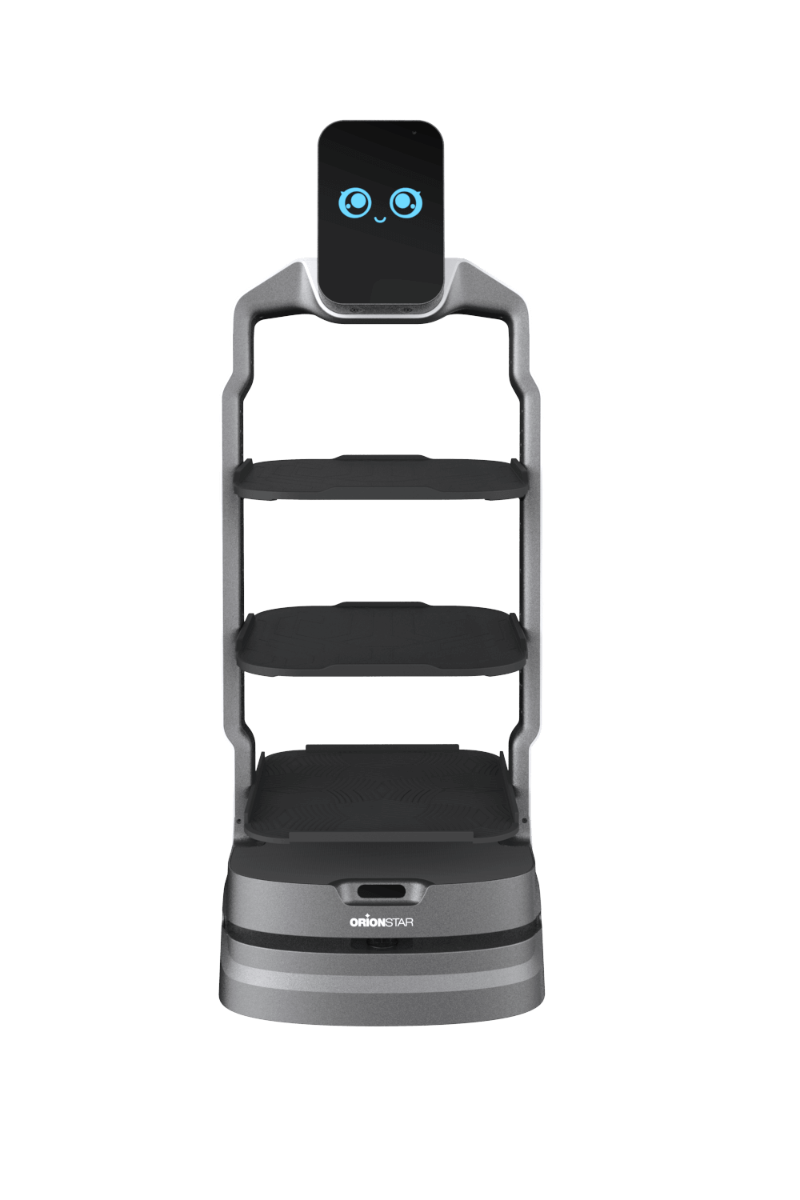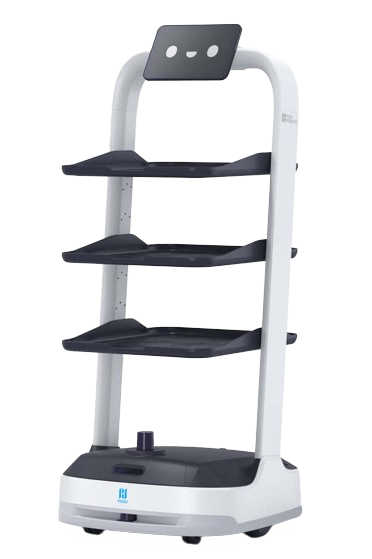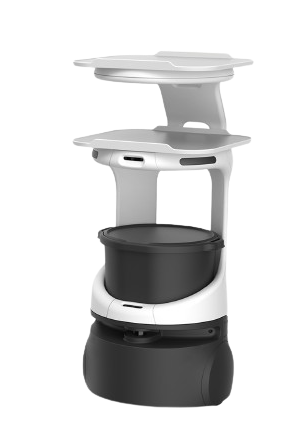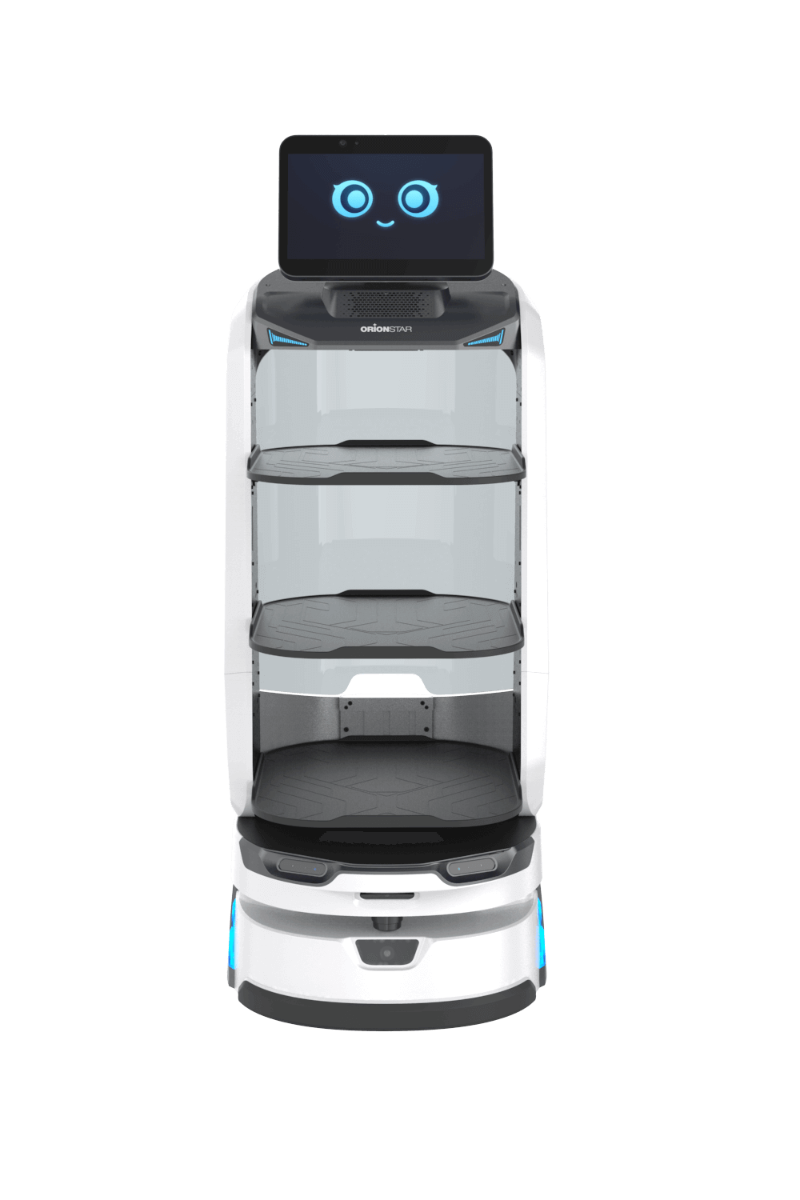Are You Looking for an Innovative Solution to Improve Service in Your Restaurant?
Are food delivery robots catching your attention? These autonomous machines, capable of delivering dishes, welcoming guests, and performing other tasks, raise many questions. You are probably wondering about the cost of a food delivery robot, the pros and cons of this technology, and how to choose the model that best suits your needs.
You're in the right place!
In this article, we will reveal everything about food delivery robots for restaurants, a rapidly growing trend in the food service industry. We will discuss the advantages of integrating a food delivery robot into your establishment, the different models available on the market, the associated costs, essential features to consider before making your purchase, as well as successful examples of food delivery robots in restaurants.
We will also discuss the potential challenges you might encounter and strategies to overcome them. By the end of this article, you will have all the information necessary to determine if food delivery robots are right for your needs and how to select the ideal model.
The Advantages of Introducing a Food Delivery Robot in Your Restaurant
Are you wondering about the benefits of integrating a food delivery robot in your restaurant? Discover the multiple advantages that such innovation can bring to your establishment.
This cutting-edge technology offers:
- Fast and Efficient Service: Capable of taking orders, serving, clearing, and cashing out via a digital interface, food delivery robots operate autonomously while avoiding obstacles. Their ability to work without interruption reduces wait times and increases table turnover, with no risk of error or fatigue.
- Significant Reduction in Labor Costs: By decreasing the need for staff, you reduce salaries, social charges, tips, and other associated costs. This also reduces the risks of musculoskeletal disorders (MSDs) and work accidents, optimizing your profitability and freeing up resources for other investments.
- Impeccable Hygiene: Designed to strictly adhere to sanitary standards, food delivery robots limit physical contact between staff and customers, a significant asset during health crises. Easy to clean, they ensure optimal sanitary safety for your customers.
- Advanced Personalization of Dishes: Thanks to their artificial intelligence, robots can adjust recipes according to customer preferences and allergies, suggest promotions or new items based on their history. Their ability to communicate in a friendly manner, supported by voice recognition, helps to retain your customers and boost your revenue.
- Revolutionary Customer Experience: True attractions, food delivery robots enhance your customers' experience with a futuristic and entertaining touch. They elevate your brand image, set you apart from competitors, and are powerful communication and marketing tools, attracting and retaining new customers.
Food delivery robots thus represent service optimization, cost reduction, improved hygiene, offer personalization, and innovation in customer experience. Easy to adopt and integrate, they are a considerable asset for your restaurant.
So, why hesitate to take the step towards this innovation?
Different Models of Food Delivery Robots Available on the Market
If you are considering integrating food delivery robots into your restaurant and are unsure which model to choose, you are in the right place. We will explore together the main models of food delivery robots available, detailing their features, costs, and additional functionalities.
We will also guide you through comparing the offers to help you make the most suitable choice for your needs and budget.
Basic Models: Features and Costs
Basic models of food delivery robots offer the essential functionalities needed for service in a restaurant. They are generally equipped with trays, a touch screen, a camera, a distance sensor, and an autonomous navigation system. These robots can take orders, serve, clear tables, and process payments, while being easy to use and configure, with no special technical requirements.
Here are some examples of basic models of food delivery robots:
Model | Brand | Price | Load Capacity | Autonomy | Dimensions |
Luckibot | OrionStar Robotics | €12,000 | 10kg per tray, 40kg in total | 12-15 hours | 530 x 500 x 1320 mm |
Pudubot 2 | Pudu Robotics | €11,300 | 40kg in total | 10 hours | 516 x 500 x 1288 mm |
Servi | Bear Robotics | €17,300 | 10kg per tray, 30kg in total | 10-12 hours | 440 x 430 x 1040 mm |



Luckibot
Pudubot 2
Servi
Advanced Models: Additional Features and Investment
Advanced models of food delivery robots enhance the customer experience and restaurant management with additional features such as artificial intelligence, voice and facial recognition, dish recognition, an ultra-wide horizontal screen, and a customizable software platform. These more performant robots can welcome guests, offer suggestions, broadcast announcements, and interact convivially, but represent a higher investment and require more complex configuration.
Here are some examples of advanced models of food delivery robots:
Model | Brand | Price | Load Capacity | Autonomy | Dimensions |
Luckibot Pro | OrionStar Robotics | €15,000 | 15kg per tray, 60kg in total | 14-16 hours | 525 x 550 x 1375 mm |
Bellabot | Pudu Robotics | €14,600 | 10kg per tray, 40kg in total | 13 hours | 565 x 537 x 1295 mm |
Servi + | Bear Robotics | €20,800 | 10kg per tray, 40kg in total | 10-12 hours | 533 x 584 x 1219 mm |



Luckibot Pro
Bellabot
Servi +
Comparison of Features and Prices
To help you select the most suitable food delivery robot for your establishment, we have created a comparative table of the features and prices of the models presented. This comparison will allow you to weigh the advantages and disadvantages of each option and evaluate the best value for money.
Here is a table comparing the features and prices of the server robots:
Model | Pudubot 2 | Luckibot | Bellabot | Luckibot Pro | Servi | Servi + |
Price | €11,300 | €12,000 | €14,600 | €15,000 | €17,300 | €20,800 |
Load Capacity | 40kg in total | 10kg per tray, 40kg in total | 10kg per tray, 40kg in total | 15kg per tray, 60kg in total | 10kg per tray, 30kg in total | 10kg per tray, 40kg in total |
Autonomy | 10 hours | 12-15 hours | 13 hours | 14-16 hours | 10-12 hours | 10-12 hours |
Dimensions | 516 x 500 x 1288 mm | 530 x 500 x 1320 mm | 565 x 537 x 1295 mm | 525 x 550 x 1375 mm | 440 x 430 x 1040 mm | 533 x 584 x 1219 mm |
Basic models offer essential functionalities for efficient service at an affordable cost, while advanced models provide enriching features for the customer experience and restaurant management, but at a higher price and with increased complexity of use.
It is important to evaluate your needs, goals, and budget before deciding on the most appropriate food delivery robot model for your establishment.
Cost Evaluation: Purchase vs. Rental
After selecting the food delivery robot model that meets your needs, you may be wondering about the best financial option: purchase or rental? What are the advantages and disadvantages of each option? And above all, what is the real long-term cost of a food delivery robot?
We are here to guide you through the differences between purchasing and renting food delivery robots, highlighting the costs associated with each option.
Purchasing Food Delivery Robots
Opting for the purchase of a food delivery robot gives you ownership of the device, allowing you to use it without time limits. However, this option requires a significant initial investment, in addition to costs related to installation, maintenance, and updates of the robot. Here are the main costs to consider if you choose to purchase a food delivery robot:
- Purchase Price: Varies according to the model and features, ranging from €10,300 to €15,000. For example, the Pudu bot ranges between €11,300 and €14,600, while the Luckibot costs between €12,000 and €15,000.
- Delivery Cost: Depends on the destination, weight, and volume of the robot, with an average cost around €500. The Pudubot2, for example, costs €450 to deliver, compared to €550 for the Luckibot Pro.
- Installation Cost: Includes staff training, configuration, and adaptation to the restaurant, with an average cost of €1,000. Installing the Pudubot2 costs €800, compared to €1,200 for the Luckibot Pro.
- Maintenance Cost: Covers repairs, replacements, and upkeep, representing about 10% of the purchase price annually.
- Update Cost: For adding new features and improving performance, count about 5% of the purchase price per year.
Renting Food Delivery Robots
Renting offers the flexibility to lease a food delivery robot for a defined period, usually from 6 months to 3 years, with a fixed monthly cost that includes delivery, installation, maintenance, and updates.
Here is what you need to know about renting food delivery robots:
- Rental Price: Varies according to the model, duration, and terms of the contract, with an average price of €2200 per month.
- Delivery Cost: Included in the rental price, there are no additional transport fees.
- Installation Cost: Also included, with no additional fees for training, configuration, and adaptation.
- Maintenance Cost: Covered by the rental price, with no additional fees for repairs, replacements, and upkeep.
- Update Cost: Included in the rental price, with no additional fees for performance improvements or feature additions.
Key Features to Consider Before Purchase
You have weighed the pros and cons between buying and renting food delivery robots for your restaurant but are still undecided on the essential criteria to evaluate to select the model perfectly suited to your needs. What are the crucial features to examine before making your choice?
Here are some key tips to guide you towards the best decision. Here are the main features to consider before deciding on a food delivery robot:
- Compatibility with Your Restaurant: Ensure that the food delivery robot integrates well with the layout, decoration, and atmosphere of your establishment. It is essential that the robot has adequate space to navigate, that its dimensions and aesthetics blend harmoniously with your furniture, and that its interaction aligns with your concept and customers.
- Load Capacity and Autonomy: It is crucial to check the robot's ability to meet the needs and pace of your restaurant. Verify if the robot can carry the number and weight of dishes and drinks you offer, if its battery is sufficient to cover the entire service duration, and if the recharge time is acceptable.
- Features and Performance: Ensure that the food delivery robot offers the expected features and performance. It is important that the robot can take orders, serve, clear, and process payments efficiently, that its navigation and obstacle avoidance are reliable, and that its artificial intelligence and voice recognition are accurate.
- Ease of Use and Maintenance: Finally, check that the food delivery robot is easy to use and maintain. It should offer an intuitive user interface, easy configuration and customization, and affordable and accessible repair and update options.
In summary, before buying a food delivery robot, carefully consider its compatibility with your establishment, load capacity and autonomy, features and performance, and ease of use and maintenance. These criteria can vary depending on the model and brand.
We recommend consulting technical sheets and user reviews of the models that interest you, or requesting a demonstration from suppliers. This will allow you to choose the food delivery robot best suited to your requirements and budget.
Examples of Successful Integration of Food Delivery Robots in Restaurants
Curious about discovering restaurants pioneering the adoption of food delivery robots? Interested in how these innovative technologies blend into various restaurant environments and concepts?
We have carefully chosen cases of effective integration of food delivery robots in establishments, both in France and internationally. Here are some of these avant-garde establishments:
- Robot.HE Restaurant in Shanghai: Located in Alibaba's Hema shopping center, this restaurant stands out with the use of about twenty food delivery robots to manage the kitchen and service. Customers place their orders via a mobile app, and the robots handle the preparation and delivery of dishes. These sophisticated robots can identify different dishes, move on rails, and interact with customers. The menu offers traditional Chinese cuisine, with specialties such as dumplings and noodles.
- Pizza Hut Restaurant in Seoul: This restaurant, located in the dynamic Gangnam district, uses a food delivery robot named Dilly Plate to serve pizzas. Equipped with a tray that can hold up to six slices, this robot navigates the floor, guided by sensors and a restaurant map. It is also programmed to greet and thank customers. The menu offers a wide range of pizzas, topped with various ingredients like cheese, chicken, or seafood.
- Noodle Topia Restaurant in Madison Heights:Facing staff shortages, the owner of Noodle Topia hired a food delivery robot named BellaBot to assist the servers. BellaBot, equipped with advanced navigation and obstacle avoidance technology, helps deliver dishes to tables, reducing the workload on human staff. The robot can carry multiple trays and greet customers with a friendly message. This innovation has helped maintain service efficiency and customer satisfaction, especially during busy hours.
As illustrated, food delivery robots integrate harmoniously into a variety of restaurant concepts, bringing originality, efficiency, and conviviality. They offer a unique opportunity to retain your customers, attract new visitors, and stand out from the competition. Why not consider integrating them into your establishment?
Potential Challenges and How to Overcome Them
Interested in integrating food delivery robots into your restaurant? Wondering about the potential challenges, risks, and obstacles?
Here is how to anticipate and overcome these challenges to successfully transition to service robotics:
- Investment Cost: Acquiring a food delivery robot can represent a financial hurdle, especially for restaurateurs with a tight budget or limited profitability. One solution is rental, which reduces the initial cost while offering a complete service. Seeking grants, financial aid, or partnerships is also recommended to finance your project.
- Resistance to Change: Integrating food delivery robots may encounter resistance from your staff, customers, or even competitors. Clear communication about the goals and benefits of your project is essential. Involving your employees, training them, and reassuring them about their future, listening to your customers' expectations to offer them a positive experience, and staying attentive to your competitive environment will help you overcome this challenge.
- Technical Reliability: Ensuring service quality involves choosing a reliable food delivery robot, benefiting from a warranty, after-sales service, and effective technical support. Conducting regular tests, updates, and preventive maintenance, as well as preparing a backup plan in case of malfunction, are crucial.
- Legal Security: Managing legal risks, particularly in case of damage or accidents caused by the robot, requires compliance with current regulations (data protection, intellectual property, security). It is also important to subscribe to appropriate insurance and ensure the conformity of the sales or rental contract.
In conclusion, although integrating food delivery robots into your restaurant presents challenges, adequate preparation, effective communication, and good management allow you to overcome them. Far from discouraging, these challenges should motivate you to get informed, trained, and accompanied to successfully complete your project.
Food delivery robots offer a unique opportunity to modernize your service and enter the era of the future of food service, with many advantages at stake.
Conclusion
If you want to boost your restaurant, optimize service, reduce costs, improve hygiene, offer personalized dishes, and provide an innovative customer experience, food delivery robots are a solution to consider. These autonomous machines can transform the service in your establishment.
This article has highlighted food delivery robots for restaurants: their advantages, various models, costs, features, and successful integration examples. We have also provided advice to navigate the potential challenges when integrating them into your restaurant.
Don't wait any longer, contact us today for a free and personalized quote regarding the ideal food delivery robot for your establishment. We promise dedicated support, quality service, and your complete satisfaction.
With food delivery robots, get ready to revolutionize your restaurant and delight your customers!